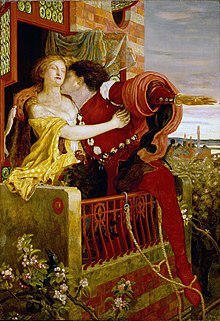| Romeo Montague | |
|---|---|
| Romeo and Juliet character | |
 The balcony scene in Romeo and Juliet as depicted by Ford Madox Brown (1869-70) | |
| First appearance |
|
| Created by | Luigi da Porto, William Shakespeare |
| Based on | Romeus, from The Tragical History of Romeus and Juliet (1562) |
| In-universe information | |
| Affiliation | |
| Family |
|
| Spouse | Juliet Montague |
| Nationality | Italian |
Romeo Montague (Italian: Romeo Montecchi) is the male protagonist of William Shakespeare's tragedy Romeo and Juliet. The son of Lord Montague and his wife, Lady Montague, he secretly loves and marries Juliet, a member of the rival House of Capulet, through a priest named Friar Laurence.
Forced into exile after slaying Juliet's cousin, Tybalt, in a duel, Romeo dies by suicide upon hearing falsely of Juliet's death.
The character's origins can be traced as far back as Pyramus, who appears in Ovid's Metamorphoses, but the first modern incarnation of Romeo is Mariotto in the 33rd of Masuccio Salernitano's Il Novellino (1476). This story was reworked in 1524 by Luigi da Porto as Giulietta e Romeo (published posthumously in 1531). Da Porto named the character Romeo Montecchi, and the storyline is nearly the same as Shakespeare's adaptation.[1] Since no 16th-century direct English translation of Giulietta e Romeo is known, Shakespeare's main source is thought to be Arthur Brooke's English verse translation of a French translation of a 1554 adaptation by Matteo Bandello.[2] Although both Salernitana and da Porto claimed that their stories had a historical basis, there is little evidence that this is the case.
Romeo, an only child like Juliet, is one of the most important characters of the play and has a consistent presence throughout it. His role as an idealistic lover has led the word "Romeo" to become a synonym for a passionate male lover in various languages. Although often treated as such, it is not clear that "Montague" is a surname in the modern sense.
- ^ da Porto, Luigi (1868). "The Original Story of Romeo and Juliet". In Pace-Sanfelice, G. (ed.). The original story of Romeo and Juliet by Luigi da Porto. From which Shakespeare drew the subject of his drama. Being the Italian text of 1530, and an English translation, together with a critical preface, historical and bibliographical notes and illustrations. Translated by Pace-Sanfelice, G. Cambridge: Deighton, Bell, and co. hdl:2027/mdp.39015082232961.
- ^ Hunter, Lynette; Lichfield, Peter (2009). Negotiating Shakespeare's language in Romeo and Juliet: reading strategies from criticism, editing and the theatre. Farnham, England: Ashgate Publishing. p. 93. ISBN 978-0-7546-5844-3.